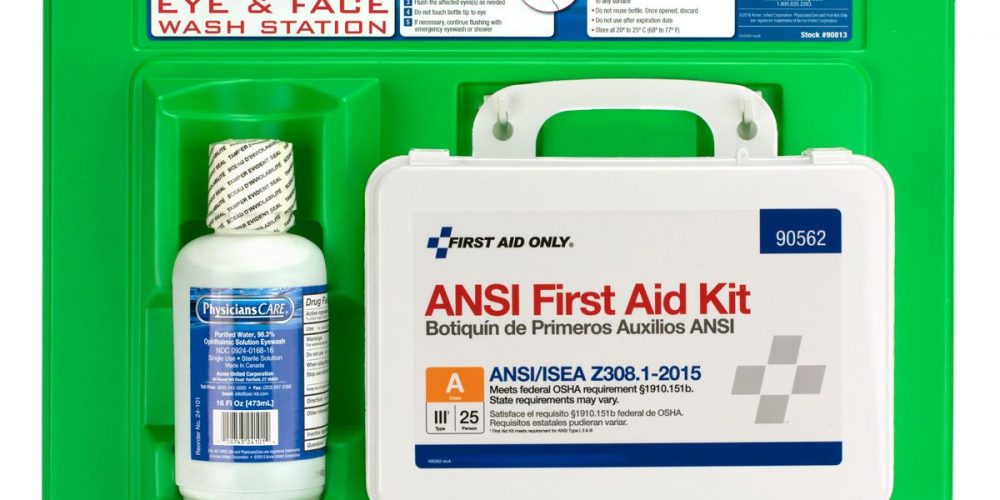- Your cart is empty
- Continue Shopping


Eyewash stations are an important safety feature in many workplaces, providing a quick and easy way for employees to wash their eyes in the event of a chemical splash or other irritant.
When chemicals or other irritants come into contact with the eyes, they can cause a range of symptoms, from mild discomfort to severe pain and vision loss. In these situations, prompt and effective decontamination is crucial to prevent further damage to the eyes.
Eyewash stations provide a dedicated space for employees to wash their eyes in the event of an emergency. These stations typically consist of a sink or basin with a continuous flow of clean, sterile water, as well as a sign or other indicator to help employees easily locate the station in the event of an emergency.
One of the key advantages of eyewash stations is that they provide a quick and easy way for employees to decontaminate their eyes in the event of an emergency. Unlike other decontamination methods, such as flushing with water from a faucet or using a water bottle, eyewash stations provide a consistent flow of water and are designed specifically for use on the eyes.
In addition to their effectiveness, eyewash stations are also easy to use and maintain. They typically require little training to use, and the water flow can be easily activated by simply pulling a lever or pressing a button. Many eyewash stations are also equipped with filters and other features to help ensure the water is clean and free of contaminants.
Despite their many benefits, however, not all workplaces have eyewash stations. In some cases, this may be due to a lack of awareness about the importance of these stations, or because of concerns about cost or space.
Overall, eyewash stations are a valuable safety feature in many workplaces. By providing employees with a quick and easy way to decontaminate their eyes in the event of an emergency, these stations can help prevent serious injuries and protect the health and well-being of employees.
To use an emergency eyewash station, follow these steps:
Locate the eyewash station. In most cases, eyewash stations are clearly marked with a sign or other indicator. If you are unsure where the eyewash station is located, ask a supervisor or coworker for assistance.
Activate the water flow. Most eyewash stations have a lever or button that can be easily pressed or pulled to activate the water flow.
Position yourself in front of the eyewash station. Stand facing the eyewash station, making sure you are within reach of the flowing water.
Open your eyes and tilt your head back. Gently open your eyes and tilt your head back so that the water flows over your eyes.
Rinse your eyes for at least 15 minutes. Allow the water to flow over your eyes for at least 15 minutes, or until the irritation subsides.
Dry your eyes and face. After rinsing your eyes, gently dry your eyes and face with a clean towel or tissue.
Seek medical attention if necessary. If your eyes continue to feel irritated or you experience any other symptoms, seek medical attention as soon as possible.
It is important to note that eyewash stations are for emergency use only. They should not be used for routine eye washing or as a replacement for proper safety equipment, such as goggles or face shields. If you are working with chemicals or other irritants, always use appropriate protective equipment to prevent eye injuries.
To test a portable eyewash station, follow these steps:
Locate the eyewash station. Make sure you know where the eyewash station is located and that it is easily accessible in case of an emergency.
Check the expiration date. Portable eyewash stations have a limited shelf life, typically about 3 years. Check the expiration date on the station to ensure it is still within the recommended time frame for use.
Check the condition of the eyewash station. Make sure the station is in good condition, with no damage or leaks.
Check the water supply. Make sure the water supply is adequate and that the water flow is strong and consistent.
Check the temperature of the water. The water temperature should be between 60 and 100 degrees Fahrenheit. If the water is too cold or too hot, it can cause further irritation to the eyes.
Test the activation mechanism. Make sure the activation mechanism, such as a lever or button, is functioning properly and that the water flow can be easily activated in an emergency.
Flush the eyewash station. Once you have checked all of the above items, activate the eyewash station and allow the water to flow for at least 15 seconds. This will help to clear any debris or contaminants from the water supply and ensure the station is ready for use in an emergency.
It is important to regularly test and maintain your portable eyewash station to ensure it is in good working order and ready for use in an emergency. If you have any concerns or questions about your eyewash station, consult the manufacturer or a safety professional for assistance.
An eyewash station should be located in a convenient and easily accessible location, close to the area where hazardous materials are used or stored. In general, the eyewash station should be located on the same level as the hazard and within 10 seconds of travel time from the hazard.
In addition to being easily accessible, the eyewash station should also be located in a well-lit area with clear signage to help employees quickly locate the station in the event of an emergency. The station should be positioned so that it is easy for employees to access the flowing water, and the area around the station should be free of obstruction to allow for easy use.
It is also important to consider the physical layout of the workspace when determining the location of the eyewash station. The station should be positioned in a way that allows for easy and unobstructed access, and it should be located in an area that is free from potential hazards, such as heavy machinery or electrical equipment.
Overall, the location of the eyewash station should be carefully considered to ensure it is easily accessible and can be used effectively in the event of an emergency.
Eye injuries are a common occurrence in the workplace, and they can have serious consequences for workers. According to the National Institute for Occupational Safety and Health (NIOSH), an estimated 2,000 workers suffer eye injuries on the job every day, and these injuries result in more than 300,000 lost workdays each year.
To reduce the risk of eye injury in the workplace, it is important for employers to provide their workers with adequate training and education on the potential hazards and how to protect themselves. This may include providing workers with appropriate protective equipment, such as safety glasses or face shields, as well as training on how to use this equipment properly.
Implementation Guide